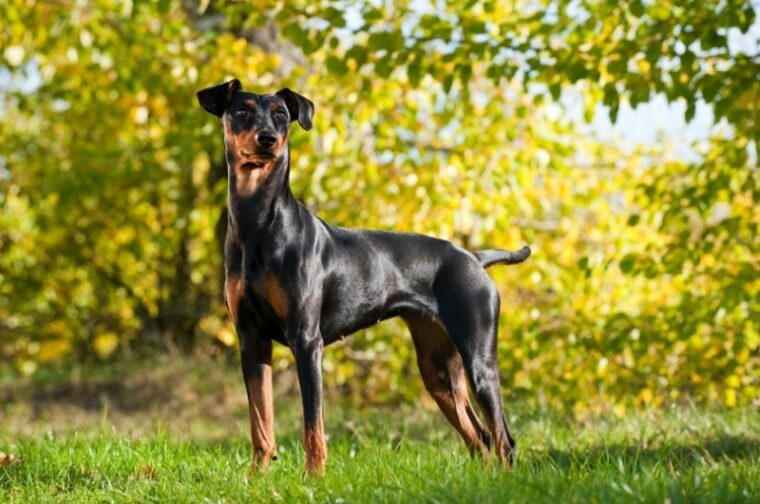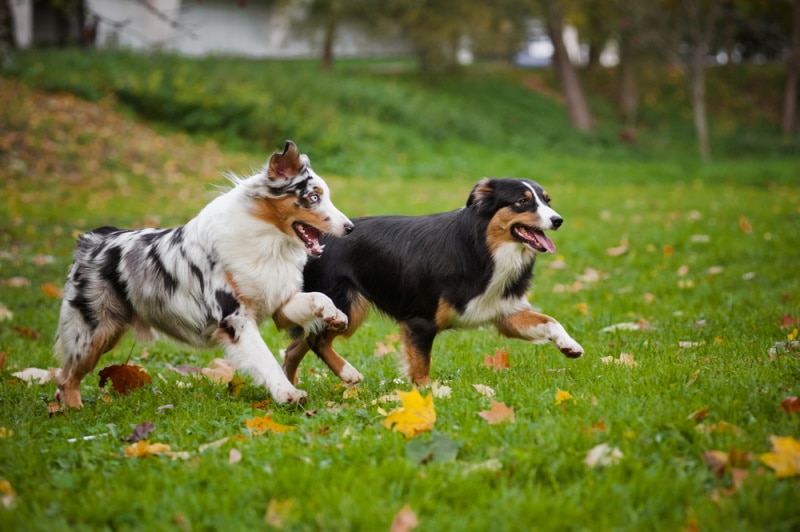
Click Below to Skip Ahead
The German Pinscher is a strong and muscular dog, hailing from Germany and first bred in the 17th Century to hunt and kill vermin. The breed is lively and energetic and, while they will adapt to life in an apartment, they will need activities that physically and mentally tire them out. The breed is considered a medium breed, will get along with all family members including older children, but it does require plenty of exercise and will retain the playfulness of a puppy even as it ages and matures.
Breed Overview
Height:
17 – 20 inches
Weight:
25 – 45 pounds
Lifespan:
12 – 14 years
Colors:
Black, brown, fawn, red, blue
Suitable for:
Active owners and families with older children
Temperament:
Loving, Lively, Energetic, Fair, Family Loving, Clever
Still used as a working dog, the Pinscher is a popular companion dog. It is intelligent so can be easy to train, although its playfulness means that the breed can be prone to bouts of giddiness and it may be easily distracted.
Maintenance of the Pinscher is relatively easy. Its short coat can be kept with weekly brushing and it is only a medium shedder.
German Pinscher Characteristics
German Pinscher Puppies
The German Pinscher is popular in its homeland, Germany, but is rare in North America and other countries. Its status as a working dog, combined with its rarity, means they can be on the pricey side. Those at the lower end of the scale tend to be considered pet quality, while those at the higher end of the scale and above are exhibition and show quality, usually with multiple award winners in their family tree.
It can be difficult to find a Pinscher breeder, so it may be necessary to travel. However, this does not mean that you should opt for and agree to purchase the first dog you see. Perform your due diligence and complete your research before you agree to a purchase.
The size and energetic nature of the breed mean that you might find one in a local rescue, but the high price and rarity of the breed means that they are not commonly given up for adoption.
Temperament & Intelligence of the German Pinscher
The German Pinscher was bred as a ratter and guard dog. The medium-sized breed is kept as a companion dog just as often as being used as a working dog, but it still retains some of its natural instincts to hunt and work. This means that the breed may not be suitable for all owners and families.
Are These Dogs Good for Families? 👪
The breed’s size means that the German Pinscher can adapt to life in an apartment, but it will require regular exercise. This may mean that the Pinscher is not suitable for seniors, or those with limited mobility.
It is also known for being quite guarded around new people, and this will include you and your family when you first bring the dog home. However, once it gets to know family members, it will become a loving, loyal, and even a protective pup.
The Pinscher will get along with people of all ages but may retreat out of the way of energetic and lively children so it will do best in a family with older and more mature kids.

Does This Breed Get Along with Other Pets?
The brave Pinscher will stand its ground against other dogs. If introduced at a young age, it may get on well enough with other family dogs, but the breed tends to retain its prey drive so you should avoid keeping it with rodents and other small animals. This prey drive may mean that the dog chases cats, too, and will typically render you unable to let the dog off its leash at the park or on walks.
Things to Know When Owning a German Pinscher:
The German Pinscher is a medium-sized dog. It was a hunter and retains some hunting instincts. It gets along with most family members but may be guarded around strangers and won’t back down from a fight with another dog.
The breed is loyal and energetic, making it ideal for some owners, but it is not a suitable breed for all families and keepers. Read on to see what is required when owning this dog, and to determine whether it is the right breed to introduce to your home.
Food & Diet Requirements 🦴
This is an energetic breed, which means that it has a hearty appetite to match. It also means that the Pinscher will benefit from being given a high-quality dry kibble. If feeding a diet consisting solely of dry food, expect to feed between one and two cups per day. This should be split over two or three meals a day and can be adjusted up or down according to how much exercise your dog is receiving, whether it is under or over-weight, and whether it has any health conditions that need to be taken into account.
You may also choose to feed a wet diet. Wet food, which comes in pouches or cans, can be more appealing to the dog. However, it smells more, does not have as long of a shelf life, and can cause more mess. Some dogs with delicate stomachs may struggle to properly digest and retain the protein and nutrients in wet food.
If you combine wet and dry food, ensure that you feed an appropriate amount of each. For example, feed half the allotted dry and wet food amounts.
Exercise 🐕
As an energetic and lively breed, the Pinscher does require daily exercise and time to play. Expect to provide a vigorous one-hour walk every day, and to provide some playtime. Providing regular exercise will help ensure that your pup is fulfilled physically and mentally and it will prevent them from becoming destructive or from showing other antisocial behavior.
Training 🎾
As well as regular exercise, good training and early socialization are vital with this breed. The Pinscher can be wary and guarded with strangers, and even with socialization, yours may never be welcoming enough to jump up at visitors to your house, but by introducing them to new situations when they are young, you can improve their confidence so that they can handle any given situation.
Training is important because it will keep the dog’s brain active, and it teaches them good behavior while discouraging bad. Good training techniques can help prevent the breed from chasing cats and small animals.
You should consider enrolling in agility or other canine sports classes. These represent a good opportunity to provide strenuous exercise for a lively dog. They also provide socialization opportunities with other dog owners that are more understanding of your plight, and most canine sports require that you have a handle of training basics.
Grooming ✂️
The coat of the Pinscher is short and requires minimal grooming, although your pup will benefit from a weekly brush because it helps spread the natural oils further. You will also have to help with brushing teeth and regularly clipping nails. Nails will need clipping every two months or when you can hear them on hard surfaces.
Health and Conditions 🏥
Although it depends on the individual dog, the Pinscher is prone to a few conditions and diseases. Look for signs of the following conditions and get your dog tested if they show any symptoms.
Male vs Female
Anecdotal evidence suggests that male dogs are more territorial but more playful and active. Some owners also allege that they are more independent. Some similar attributes are seen in unspayed females. Males also tend to grow a little taller and heavier than females. However, individual traits are more important in determining the character of a dog than what sex they are.
3 Little-Known Facts About the German Pinscher
1. They Are Exceptional Working Dogs
The specific German Pinscher breed was first created in the 19th century. It was used in stables to hunt and kill vermin and to keep horses and livestock healthy and safe. The Schnauzer is considered a rough-haired Pinscher and it is also known to be an excellent ratting and hunting dog.
Today, the breed is used as a guard dog because it is alert and will bark to let you know of approaching strangers and unusual situations. Even if they are not used as guard dogs, the breed instinctively wants to look after family members.
2. The German Pinscher Comes from the Rattenfanger
Although the Pinscher breed is said to date back to the 19th century, it is believed to have been bred from the Rattenfanger, from the 1600s. He was used as a watchdog and was renowned for his ratting skills. This traditional breed was crossed with Black and Tan Terriers to give rise to the Pinscher and it is this crossing that gave the breed its black and brown coat.
The breed standard was created in 1884 but it did not become popular thanks to the wars. At the beginning of the 20th Century, the breed nearly became extinct, and it took the concerted efforts of breeders and four large iterations of the Miniature Pinscher to re-establish the breed. The German Pinscher was only recognized by the AKC in 2003.
3. The Breed Smiles at Owners
The breed is known as a loyal breed that protects and guards its family. It’s also known to smile or grin at its owners. Some people mistake this for an aggressive gesture, but it is not accompanied by growling or any type of vocalization. It’s more likely to smile if the Pinscher is being submissive or believes that it has done something wrong or been mischievous. The Pinscher can be mischievous, but this is usually caused by a lack of regular exercise. A bored dog is a destructive dog, while a tired dog is a well-behaved one.
Final Thoughts
Whether you buy or adopt, and whether you get a male or female, the German Pinscher is a medium-sized brown and black dog. It was originally bred for ratting, and some Pinschers can still retain this hunting prey drive. They tend to make good guard dogs, can still be used as effective working dogs, but also make excellent companions that adapt to apartment life but do require a lot of exercise and socialization to ensure that they grow up as friendly and well-adjusted dogs.
Featured Image Credit: Dora Zett, Shutterstock








